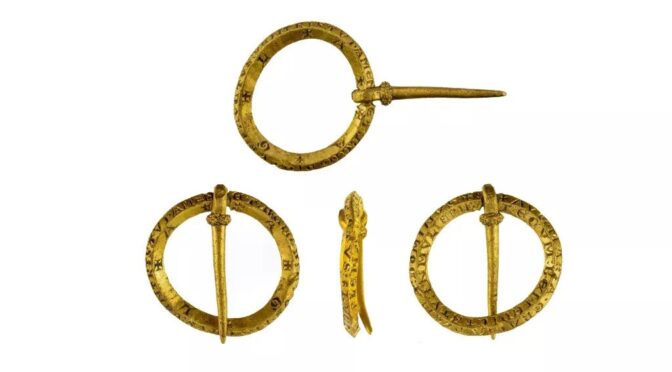A medieval gold brooch with Latin and Hebrew inscriptions was unearthed by a metal detectorist. The object, which was discovered in Wiltshire, England, may have combined religion and magic in an attempt to protect its owner from disease or paranormal elements.
“Hail Mary, full of grace, the Lord is with thee/ blessed art thou amongst women/ and blessed is the fruit of thy womb. Amen,” the Latin inscriptions read. The Hebrew initials “AGLA” are also engraved on the brooch, and they stand for the Hebrew phrases “Thou art mighty forever, O Lord.”
According to a brief report on the brooch published online by the Portable Antiquities Scheme (PAS) and written by Sophie Hawke, a discoveries liaison officer for PAS, the gold brooch dates to between A.D. 1150 and 1400 and may have been used in an attempt to avoid fever. Metal detectorists in England and Wales record their finds to the PAS, a government-sponsored organization that posts reports and photographs of the finds on its website and occasionally in academic journals.

Live Science spoke with a variety of medieval history and magic experts to obtain their opinions on what the brooch could have been used for.
Some experts believe the Hebrew initials that symbolize the words “Thou art great forever, O Lord” are significant to the brooch’s function. In an email to Live Science, Richard Kieckhefer, a professor of religious studies at Northwestern University, said that this term “features heavily in medieval magic.”
The other prayers etched on the brooch, he pointed out, were regular religious prayers at the time. “What I’d like to underline is that this sort of combination of religion and magic is not uncommon,” Kieckhefer said, adding that the brooch’s combination of religious and magical meanings would have given it exceptional powers in the eyes of the creator.
In an email to Live Science, Frank Klaassen, a history professor at the University of Saskatchewan, said the Hebrew initials for “AGLA” were “quite often employed in magic, from high ritual magic to protective pendants and charms.” “In ancient traditions, it is one of many holy names or powerful words.”
But why would someone wear a brooch like this?
“Wearing Bible verses like this was occasionally done as a form of shielding a person against disaster,” such as fire, sudden death, or supernatural forces like demons, according to Catherine Rider, a medieval history lecturer at the University of Exeter in the United Kingdom. “It’s difficult to say if it’s magical – it’s probably somewhere in the between of what we’d call magic and religion.”
Given the modest size of the brooch and the name of the Virgin Mary, the person who wore it was most likely a woman. According to Karen Jolly, a history professor at the University of Hawaii at Manoa, “I would think it was used on a woman’s clothes of some light fabric” because of its “small, yet lovely” size. “This woman was wealthy enough to own or have been given the object. Whether she was literate or not, she would understand what it said and meant,” Jolly said, adding that the brooch could have performed a protective function throughout pregnancy and labor.
The brooch was well-made, with its tiny engraved lettering. In an email, Anne Lawrence-Mathers, a history professor at the University of Reading in the United Kingdom, said, “My main reaction to the brooch is that it was made by someone who was highly skilled and that its first owner, at least, was a pious person who recorded on it both devotion to the Virgin and a charm to protect them against various threats.”
The brooch is currently undergoing the Treasure Act process, as required by British law. It’s a procedure for determining what will happen to an item. Depending on a variety of variables, it may wind up in a local museum. One possible consequence is that the metal detectorist receives a monetary prize and the relic is turned over to the government, which may decide to display it in a museum.






















